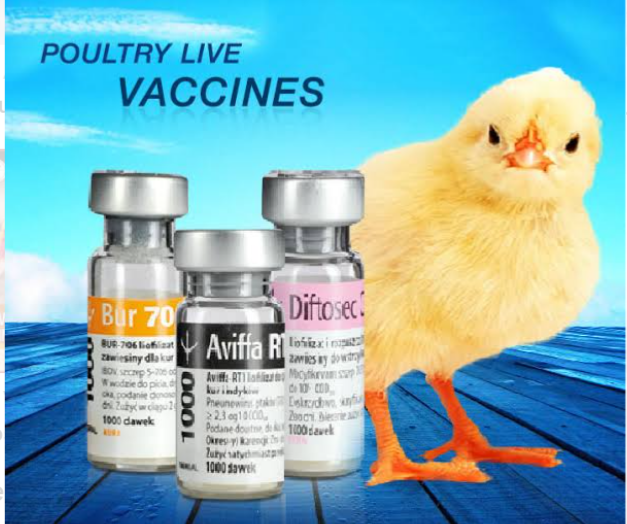
Poultry birds should be properly taken care of to prevent diseases and maintenance of good hygiene will make the birds resistant to diseases.
Vaccination is an artificial infection resulting in immunity. It involves the administeation of a dead or weakened pathogen (virus, bacteria and parasite ) into the body of birds in a regulated manner. Therefore, Vaccination can be carried out using vaccines. Vaccines can be antibacterial, antiviral and antiparasite vaccine. It plays a vital role in the poultry health management.
Some of the diseases farmers manage by vaccination include
Marek’s disease, Newcastle disease, infectious bronchitis, infectious bursal disease, fowl cholera, mycoplasmaosis, infectious coryza, colibacillosis, salmonellosis, Reovirus, coccidiosis, Encophalomyelitis, fowl pox, chicken infectious anaemia, laryngotracheitis etc.
It is important for farmers to design their own vaccination program. This can be done by consulting their veterinarian. Vaccination is carried out when the birds are healthy and not sick. Sick or weak birds should not be vaccinated as the vaccines will have no effect} on the disease. Note that vaccines boost the birds immune system. Therefore, when the bird is infected by or exposed to the disease, the immune cells would fight and overcome the disease making the birds not to be infected.
There are different vaccine. Some are for layers, broilers, breeders, etc.
IMPORTANCE OF VACCINATION
1. The major importance of vaccines is to protect birds against specific infectious diseases. 2.In layers birds, they are needed to ensure that maternal immunity is passed to the chicks and to prevent vertical transmission of infections.
3. Prevent the birds from death which may affect the farm production
PURCHASE OF VACCINES
1. Vaccines should be purchased from a reliable source, or veterinarian store. The vaccine type, doses age, expiry date, and the sealing should be checked
2. Vaccines are stored in a cold medium. Therefore, when purchasing the vaccines, ice block in a flask should be carried along to store the vaccine before arriving the farm
3. Vaccines should not be freezed or placed in the freezer but keep in the cold part of the refrigerator
4. If the vaccine is not protected, it’s potency would reduce
5. For the birds, the right dosage must be used
6. After vaccination, the vaccine container or vail should be disposed by burning it in the soil or by burning it because it contains attenuated virus
7. Vaccines must be used immediately and must not exceed 30 minutes after mixture without usage. Some have lifespan that exceed 30 minutes.
TYPES OF VACCINE
There are two types of vaccines
1. Live vaccine or Attenuated vaccine
2. Inactivated or dead vaccine
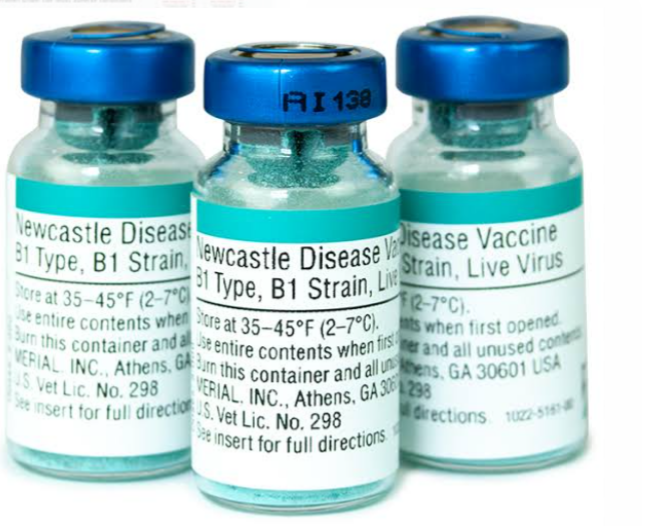
LIVE VACCINE OR ATTENUATED VACCINE
live vaccines are vaccines in which the pathogens in them are still alive, although weak. They are usually administered in drinking water or by spray application, though some live vaccines require individual application by eye drop or administration by injection.
The lifespan of Live vaccines is short. There lifespan is between 1 to 2.0 hours. Therefore, administration of the vaccine should not exceed the lifespan. Some vaccine lifespan are shorter.
INACTIVATED OR DEAD VACCINE
Inactivated vaccines are vaccines in which the pathogens in them are already dead. They are mainly used in breeding or laying stock and they are administration by injection. They contain adjuvant which help optimize the immune response to the antigen. Adjuvants used include mineral oils and aluminium hydroxide.
LOCAL VACCINE VERSUS EXOTIC VACCINES
Vaccines can be either local vaccines or imported vaccines. Vaccination can be done locally such as eye drop, spray and oral vaccination. Imported vaccines are cheaper to use based on the cost and dosage than local vaccines. Local vaccines vail contain 200 doses while imported vaccines contain 1000 doses of vaccines which are used for 200 and 1000 birds respectively. The only disadvantage of imported vaccine is that they are produced to serve a particular climatic area. Imported vaccines manufactured in the temperate region are not adviseable to be used in the tropical region because it is mainly made for temperate bird production where the weather is cold. Local vaccines manufactured for tropical region where the temperature is high is produced to suit bird production in the hot environment.
IMPORTANCE OF LOCAL VACCINE
1. It provides an immediate local protection by virus
2. It is less risky compared to injection. It circulate antibiotics faster and
3. Local vaccines are cheap to purchase
ADMINISTRATION OF VACCINE
The most convenient time to vaccinate birds like chicks is before they leave the hatchery. It is also crucial to note that there are certain times, and ages best for vaccination. Not vaccinating at the appropriate time result to loss of birds. Therefore, vaccination program is needed. The factors to consider when planning to vaccinate chicks include: ages, doses, routes of administration, and the appropriate environmental conditions required before vaccination. Different vaccines are administered at different ages. When handling vaccines, spillover of the vaccines should be avoided because an outbreak of diseases can occur from the spill on the farms. Therefore, the emptied vaccine vail or containers should be properly disposed.
Vaccine can be administered through:
Drinking water.
Spray/nebulization (Chicks in the housed environment).
Eye drop.
Transfixion and scarification (cutaneous route in the wing web or foot).
Injection (intramuscular or subcutaneous).
In-ovo administration.
METHODS OF ADMINISTRATION OF FOWL VACCINE
Fowl vaccine can be administered by
1. Local vaccination on the mucosa
2. Injection of vaccines underneath the skin ( Subcutaneous injection)
3. Vaccination in the SKIN (intermuscular injection)
4. Ocular
5. Nasal
6. Oral
7. Spray
INTRAMUSCULAR INJECTION
This is the use of a needle (syringe) to inject the vaccine into the breast muscles of the chickens. Use of automatic syringe is a faster and easy process of administration and it does not cause harm to the bird. The correct dose must be administered.
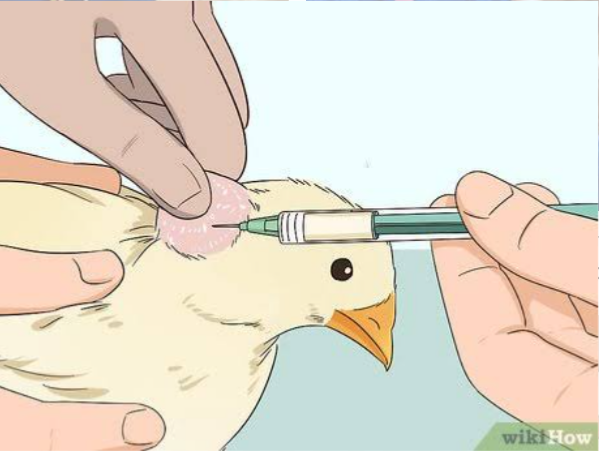
SUBCUTANEOUS INJECTION
This method is similar to intramuscular injection. The vaccine is injected under the skin, usually at the back of the neck. Handlers of vaccine should make ensure that the vaccine is injected into the bird and not just into the feathers. It is the method commonly used for fowl pox vaccination.
OCULAR
The vaccine is administered to the birds eye using an eyedropper.
Vaccination using eye drop vaccination is also
called intra occular vaccination. The vaccine is dropped into the eye and comes in close contact with the mucous membrane of the eye. It also passes through respiratory tract to the lacrimal duct. Chicks should be vaccinated on the third day with intra occular vaccine. Some farmers vaccinate their chicks on the fifth day after purchase. The effectiveness of the vaccine on the bird will be seen as by birds licking after administration of the vaccine.
Eye drop vaccine is used for treatment of diseases such as Newcastle diseases, infectious bronchitis, and infectious laryngotracheitis. All are viral diseases.

ADMINISTRATION OF EYE DROP VACCINES
The birds have to be handled individually to administer the vaccine. This takes time to yield good result
NASAL
The vaccine is introduced into the birds’ nostrils which the birds inhale. These vaccine are manufactured in form of dust or as a liquid drop.
ORAL /DRINKING WATER
This method is effective in mass administration of vaccines to large numbers of poultry.
The vaccine is mixed with the birds drinking water or dropped with dropper into the fowls’ beak. As they swallow the vaccine, the vaccine make its way to the respiratory system or get to the digestive tract before entering the body. Most live vaccines are administered in water. Note, water treated with chemicals should not be used. For chlorinated water, application of skimmed milk powder to the water is a simple and effective way to overcome the detrimental effects of the chlorine. Enough drinkers should be provided to ensure that all birds have access to the vaccine water at the same time to and to minimize exceeding the vaccine lifespan. Any leftover vaccine should be discarded after exceeding it’s lifespan.
Oral administration of vaccines can only be successful if the virus can survive the acidity level in the stomach of the chicks. Oral can also be administered by subcutaneous, or intra muscular by injection which is the only way to administer dead vaccines.
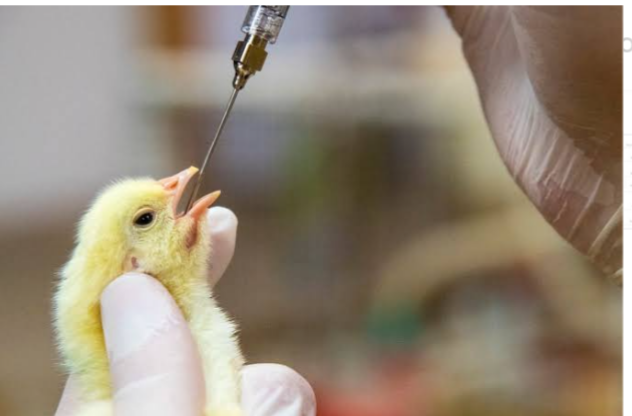
SPRAY
The vaccine is sprayed on the birds, or into the air above the birds using a spray applicator. As the vaccine fall on the birds, it enter the body. Other birds that pick on the shiny feathers of birds with vaccine droplets also ingest the vaccine into their body. Vaccine droplets in the air may also be inhale in small quantity by birds. It is effective in immunizations of large numbers of birds.

IN-OVO ADMINISTRATION
This is a new technology developed in which the vaccine is administered into fertile eggs through the air cell. The egg is vaccinated at three weeks of incubation using a special machine.
The system has being used for administration of Marek’s disease vaccine, infectious bursal disease vaccine, fowlpox, avian influenza and a number of other types of live vaccine.
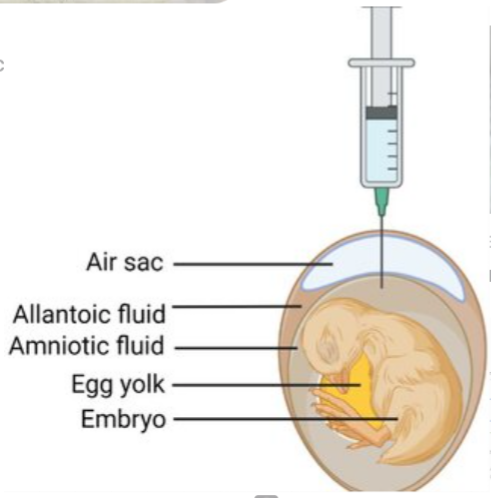
TYPES OF WATER USED FOR VACCINE DILUTION.
The water advisable for diluting vaccines include distilled water, rain water, well water, borehole water can be used as solvent. Water that contain chemicals are not adviseable for use as they reduce the potency of the pathogens.
MIXTURE OF VACCINES
Live vaccines such as gomboro should be mixed with milk to reduce the surface tension and neutralise the effects of some undissolved salts before administering the vaccine to the birds. For intra occulla vaccines, oral administration is used.
PRECAUTIONS TO TAKE IN VACCINE ADMINISTRATION
1. For vaccine injection, handlers of vaccine should be trained in the administration of the vaccine at the right position in the breast muscles and underneath the skin.
2. Vaccine handlers should ensure that the needle does not pass into any of the key organs.
3. Handlers of vaccine and equipment to use must be in good hygienic condition. And proper vaccine handling procedures must be maintained to prevent unnecessary contamination.
4. All equipment used for vaccination must be carefully cleaned and completely free of disinfectants and detergents (note that live vaccines administered through the drinking water can be destroyed by disinfectants and soap). Therefore, cold, fresh and clean drinking water must be used
5. When vaccines are to be mixed with water, the vaccine bottle should be opened under the water.
6. Before administering vaccine mixed with water to birds, make sure the birds are thirsty to stimulate the intake of an adequate dose of the vaccine. This can be done by starving the birds overnight without water and feed. For example, lasota vaccine.
7. All the water present in the drinkers and nipple lines should be consumed by the birds prior to vaccination
8. For good effectiveness of vaccines, a well-designed vaccination program combined with proper management, good nutrition and a well followed biosecurity program should be maintained.
9. In ovo administration, a good hatchery sanitation and proper disinfection of the hatching eggs must be carried out
SOME INFECTIOUS DISEASES IN POULTRY TREATED USING VACCINES
1. ANTIBACTERIAL VACCINES :
a) PASTEURELLOSIS
Fowl cholera is caused by Pasteurella multocida,. It affects both fowl and turkeys. P. multocida vaccines include bacterins adjuvanted with aluminum hydroxide or oil emulsions, or they may contain attenuated live organisms.
b) MYCOPLASMOSIS
These diseases are caused by several pathogenic Mycoplasmas. The most important are Mycoplasma gallisepticum (MG) and Mycoplasma synoviae (MS). Mycoplasma gallisepticum causes chronic respiratory disease, whereas Mycoplasma synoviae causes respiratory disease or synovitis
c) INFECTIOUS CORYZA
This is an acute respiratory disease of fowl caused by Avibacterium paragallinarum. It is characterized by nasal discharge, sneezing, conjunctivitis, diarrhea, and facial swelling. Affected hens show a significant drop in egg production. Coryza may be complicated by the simultaneous presence of many other bacteria in addition to infectious bronchitis virus
d) SALMONELLISIS
Salmonellae present the poultry farmer with two potential problems. One is the fact that they may kill large numbers of birds. The other is that they may cause human food poisoning caused by the contamination of eggs and poultry meat with Salmonella enterica serotype Enteritidis. This is of major concern to the poultry industry.
ANTIVIRAL VACCINES
1. NEWCASTLE DISEASES: This is a serious viral disease in poultry. It spread through infected droppings and respiratory discharge, transportation of infected equipment, personnel, truck, wild birds or by air.
CLINICAL SIGNS: High mortality, depression and difficulty in breathing
2. MAREX DISEASE OR NEUROLYMPHOMATOSIS: It occurs in birds between 12 to 16 weeks old. Day old chicks become infected by oral respiratory route. Marek’s disease is primarily controlled by Mareks vaccine which is administered either in ovo at day 18, or by subcutaneous injection at day of hatch. The vaccine is not used for broiler or breeder stock but used for pullets that spend more than a year on the farm.
CLINICAL SIGNS: loss of weight, paralysis, one leg stretches forward and the other backwards
3. INFECTIOUS BURSAL DISEASE
Also called Gumboro disease, the causal agent of IBD is an avibirnavirus.
It infects multiple bird species, but causes clinical disease only in fowl less than 10 weeks of age
4. INFECTIOUS BRONCHITIS
Infectious bronchitis is a respiratory disease of fowl that also causes nephritis, decreased egg production, poor growth, and high morbidity. It is caused by a gammacorona virus, avian infectious bronchitis virus (IBV). The combination of high morbidity, and loss of performance, together with secondary bacterial infections can lead to unsustainable losses
5. AVIAN REOVIRUSES
Avian reoviruses belong to the genus Orthoreoviruses in the Reoviridae family. They cause arthritis/tenosynovitis, proventriculitis, a runting-stunting syndrome, and “blue-wing disease” in broilers. These diseases affect very young birds. Reovirus vaccines are often administered to breeding hens to stimulate maternal immunity and protect the newly hatched chicks.
6. FOWLPOX
Fowlpox is caused by an Avipoxvirus. They are transmitted through aerosols or by biting insects. It is a slowly spreading infection characterized by proliferative skin lesions (dry pox) on unfeathered skin, or by diphtheritic lesions in the mucosa of the mouth, esophagus, larynx, or trachea (wet pox). The latter can result in asphyxiation of young chicks.
7. EGG DROP SYNDROME
Egg drop syndrome (EDS) is caused by an adenovirus infection in laying hens. It is characterized by production of soft-shelled and shell-less eggs.
ANTIPARASITE VACCINES
COCCIDIOSIS
Coccidiosis Infection is caused by a parasite called Eimeria coccidia. Live coccidial vaccines are used in controlling the disease . These vaccines typically contain live sporulated oocysts from multiple Eimeria species and strains. Live coccidiosis vaccines are delivered to day-old chicks either at the hatchery or on the farm by spray application, gel, or feed vaccination. Administration on feed involves spraying the feed with the diluted vaccine to moisten it before feeding to the birds.
.
